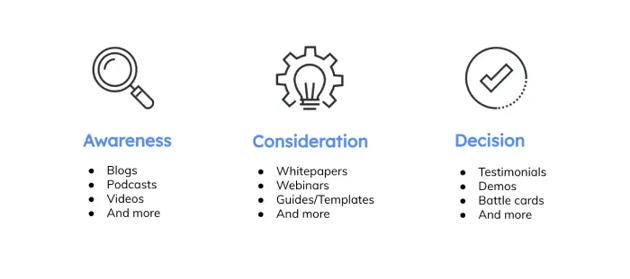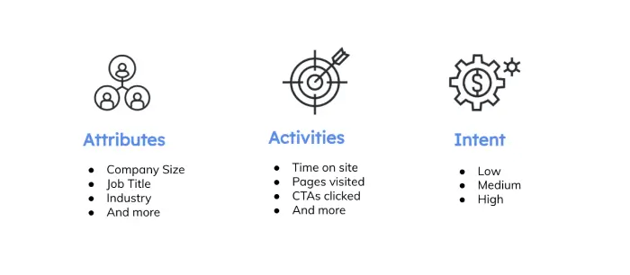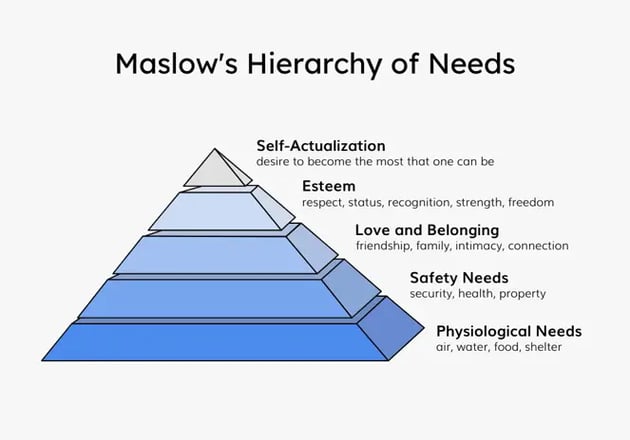The Power of Multi-Channel Marketing for B2B SaaS Companies
Get your B2B SaaS company in front of the right customers with multi-channel marketing. Drive growth and establish your brand as an industry leader.

Does your B2B lead nurturing strategy need a refresh?
In order to effectively nurture your B2B contacts and leads to improve lead quality, you need two things––targeted content and a solid plan. Without them, your nurture sequences can actually hurt your pipeline and lead to several missed opportunities.
According to Forrester Research, companies that excel at lead nurturing can generate 50% more sales-ready leads at a 33% lower cost.
Lead nurturing is about adding value and delivering the right message to the right people at the right time, making targeted content a crucial factor in your nurture campaigns. To do it right, there are several things to consider and it all starts with the funnel stages of your contacts.
The goal of any nurture campaign is to move contacts down your funnel. A common pitfall that most marketers assume is that nurturing is only about turning leads into MQLs –but this is not the case. It may be a focus for the marketing team, but you should also consider all the funnel opportunities for lead nurturing, as well as the all-up goals of the company.
Perhaps Sales is looking to get support from Marketing to drive contacts through the Opportunity stage. In this case, testimonials from existing customers can close the sale –or maybe Customer Success is looking for content that makes customers feel confident in making the purchase to help move them into an Evangelist. In any case, you should always keep an eye out for opportunities where your marketing content can support and add value.
You can even create content for lead statuses. For example, were there people who were disqualified due to budgetary reasons, time constraints, or perhaps any wrong decision makers that we are able to create relevant content for to push them back in the running? Your contact may not have the money, time to implement, or be the appropriate decision maker now, but that doesn’t mean that they won’t eventually. Keeping your company top of mind makes the decision making a lot easier when the time is right for your prospect. Never burn relationships and always keep good clean data when it comes to your funnel.
In virtually all cases, considering the funnel stage and lead status will help you inform the appropriate messaging and targeted content to use for the contact. This will also help you set the goals of the campaign, and help think about what the best content would be to move your contacts through the funnel.
To learn more about how you can set up your own funnel stages and lead status, or get a template –click here.
Boost awareness, kickstart organic growth, and get content marketing support for every stage of your marketing funnel. Leverage our team of specialists and a custom GTM strategy to start seeing impactful results.
There are several best practices when it comes to templatizing the right content for the right stage in the buyer’s journey. Here’s what we’ve found to be the most successful through our work and support for dozens of B2B SaaS companies.

It is important to note that this is neither an exhaustive list nor a rule that you should follow –rather this should be utilized as a kick-off point to get you thinking. It is very possible that you can create webinars for awareness, or blogs for conversion –it really depends on what your audience is looking for, what resonates best with them, and what channels they’re on.
If you haven’t already, implementing a lead scoring or lead grading model will prove wonders for creating targeted content. It helps paint a more granular picture into the types of attributes, activities and intent of your target audience –therefore making it easier to create content that speaks to them.
Of course, there are a multitude of dimensions that one could ‘score’ their leads, but a simple yet effective methodology we typically start with looks like this:

Let’s explore some of these in more detail:
This one is fairly straightforward and is all about the judgement you make as a marketer with the data points you are able to acquire.
Of course with any of the options, if you know exactly what your contact looks like, you will be able to create content that really resonates deeply with their current needs to push them further through the funnel.
One more thing to consider is the priorities of the department –what is Marketing looking to do? How about Sales, Customer Success, or the CEO? This will help you make your judgement of which stakeholders you should target first –perhaps there is a dire need of more MQLs, in which case you should create hyper-focused content for high intent personas.
When you think about creating content, it is also important to think about what the customer needs––what are they looking for, what are their pains? Is there a category that we can bucket our contacts into where we either are solving a common problem that they have, or maybe a job to be done? We need to create targeted content that makes them scream “I identify with that” and use language at their level. Utilizing Maslow’s Pyramid will do just that. It will not only help you inform the content that will speak to your contacts, but also the title of the piece to grab their attention.

One common pitfall we see is that many assume “Well we’re marketing to businesses, not people. These needs are different” and this is most certainly not the case. It doesn’t matter if you’re selling to a Mom and Pop or a large global corporation. At the end of the day, we are selling to the people behind it. The owner, CEO, manager, or employees of these businesses all have pains, fears and dreams. The goal here is not about creating content that solves their problem, but rather about adjusting your language and tone to empathize with the contact.
Take for example, a Father & Son paper company that pitches their paper products to a Father & Son law firm. Perhaps they all can empathize with the struggles of having a dad micromanage your work, or a son that isn’t picking up the slack. In this instance, the sale is more likely to happen as a result of a personal connection and empathetic understanding of each other’s pains. As such, you should always consider getting eye-to-eye with your contact to help bring them through their nurture journey.
Think in the shoes of your customers and ask yourself “what’s in it for me?” You should always aim to create content that delivers strong value for the customer and consider where they are in the buyer’s journey. Valuable content can range from something as simple as answering a burning question, right down to an ROI calculator that shows how much they can save with your solution.
It is also equally as important to focus on the pains and gains that the customer can expect, not necessarily the claim your solution is making. No one ever wants to hear about someone else, everyone is always looking to talk about themselves, your leads included. To learn more about our pain-claim-gain messaging methodology –click here.
The following template makes it easy for everyone to get on the same page –to rally behind a common goal. It offers a view to easily plan your targeted content and nurture sequences so automation can set up the right lists and workflows and the CMO can understand the strategic vision of the nurture campaign.
Consider tying your nurture campaign in with your content calendar to ensure that the right cadence is sent to all audiences. It’s almost important to consider the amount of time it takes for your writers, designers or automation specialists to get the content up and running. Learn more on how to create your first content strategy and content calendar with a free template.
When utilizing the template, it is best to consider the difference between the micro and macro view of the content needs. From a micro perspective –this enables you to think about how a buyer's journey looks over the course of the campaign, as well as the relevant content needed based on the changing needs of customers’ over time. From a macro perspective –it's all about the overarching goal of the campaign and thinking about the larger, overall intent to help inform content.
For example: A macro view could entail a goal of converting high intent leads in Germany into MQLs, and a micro view could be the frequent changes in content as your contact moves through the awareness, consideration and finally conversion stages–and possibly a new list every time someone unsubscribes or is filtered out.
Consider what your intentions are from the very beginning for that group of contacts you’re nurturing. Just like a relationship, if your intention is to marry the other person, you would never propose on the first date because they would simply run away and block your number. Don’t come off strong. Instead, think about the gentle escalation and make it so that your contact becomes ready for the final stage in the nurture process.
Let’s continue to use the marriage example. Consider what a strong relationship looks like, you start by getting to know each other casually, then you move into learning about common likes and dislikes. Later you dive deeper and ask what makes them vulnerable and learn about their future aspirations. Over time, you ask harder questions like “do you want to move in together?” and finally, you pop the question.
Similarly, when creating content, think about gently providing more and more value overtime based on how the contact is feeling at that certain point. It’s important to deliver the right messaging that shows you understand what they need and that you are there for them as a trusted guide. When appropriate, carefully introduce higher intent content that hints and a close. Don’t be afraid to ask the tough questions when you feel the time is right.
It is very possible that your contact decides to go another direction –maybe they’re not ready to purchase, or become a proven customer testimonial. Referencing our previous example, it’s possible that your partner said “no” because they simply don’t like weddings, don’t have the money for it, or their parents didn’t approve cause you’re lacking something today.
Similarly, it’s possible that your contact doesn’t like signing for a 2 year contract, doesn’t have the budget to spend today, or the key decision maker didn’t approve because your offering currently lacks a certain feature. This doesn’t mean it’s over, but rather another opportunity to create better content for more targeted nurturing–to sell them on an idea that highlights other benefits you are able to offer –which ultimately brings us back to the beginning of this article on nurturing content for the appropriate lead status.
There’s a lot to consider when building targeted content for your nurture sequences, and in a crowded marketplace, it’s important to stand out. Lead nurturing may be time-consuming, complicated, and tedious, but it’s worth the hard work when you close deals.
By engaging your contacts with the right content at the right time, you can keep your brand top of mind, establish yourself as an industry leader, and build lasting relationships with your B2B clients.
Boost awareness, kickstart organic growth, and get content marketing support for every stage of your marketing funnel. Leverage our team of specialists and a custom GTM strategy to start seeing impactful results.
Fadi co-founded Kalungi in 2018 with Stijn Hendrikse. He has over 20 years of experience in marketing and building businesses. He is a certified HubSpot Champion User.
Get your B2B SaaS company in front of the right customers with multi-channel marketing. Drive growth and establish your brand as an industry leader.
Whether B2B SaaS companies don’t have the time to build their first in-house team or don’t want to invest in another marketing agency selling empty...
Get your B2B SaaS pricing right. Explore different models and strategies to find the perfect fit for your business and your customers.
Be the first to know about new B2B SaaS Marketing insights to build or refine your marketing function with the tools and knowledge of today’s industry.